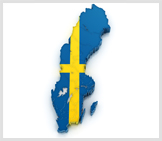To learn everything about the European Union: a full, up to date analysis of the Member States, the Union and the euro area.
 A model Welfare State, Sweden is extremely attached to the neutrality of its foreign policy, undoubtedly due to its turbulent history. Indeed the Swedish State was already centralised in the 13th and 14th centuries, following that it became part of the Kalmar Union until 16th century. In 1520 Sweden rebelled and left the Union. In the 17th century it was the biggest power in Northern Europe, including Finland and many other territories that it lost in 1721 after a long “War in the North.” Following that a new union with Norway was created in 1814 but this was dissolved peacefully in 1905. It entered the EU after the end of the Cold War in 1995 but did not adopt the euro. It maintains an extremely intergovernmental vision of the EU and defends enlargement as a means to spread the rule of law and the market economy.
A model Welfare State, Sweden is extremely attached to the neutrality of its foreign policy, undoubtedly due to its turbulent history. Indeed the Swedish State was already centralised in the 13th and 14th centuries, following that it became part of the Kalmar Union until 16th century. In 1520 Sweden rebelled and left the Union. In the 17th century it was the biggest power in Northern Europe, including Finland and many other territories that it lost in 1721 after a long “War in the North.” Following that a new union with Norway was created in 1814 but this was dissolved peacefully in 1905. It entered the EU after the end of the Cold War in 1995 but did not adopt the euro. It maintains an extremely intergovernmental vision of the EU and defends enlargement as a means to spread the rule of law and the market economy.